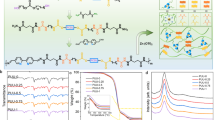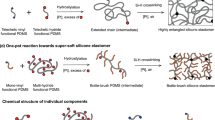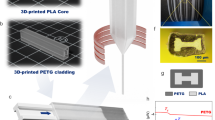Abstract
Stimuli-responsive (active) materials undergo large-scale shape or property changes in response to an external stimulus such as stress, temperature, light or pH1,2. Technological uses range from durable, shape-recovery eye-glass frames, to temperature-sensitive switches, to the generation of stress to induce mechanical motion3,4,5,6,7,8,9. Here, we demonstrate that the uniform dispersion of 1–5 vol.% of carbon nanotubes in a thermoplastic elastomer yields nanocomposites that can store and subsequently release, through remote means, up to 50% more recovery stress than the pristine resin. The anisotropic nanotubes increase the rubbery modulus by a factor of 2 to 5 (for 1–5 vol.%) and improve shape fixity by enhancing strain-induced crystallization. Non-radiative decay of infrared photons absorbed by the nanotubes raises the internal temperature, melting strain-induced polymer crystallites (which act as physical crosslinks that secure the deformed shape) and remotely trigger the release of the stored strain energy. Comparable effects occur for electrically induced actuation associated with Joule heating of the matrix when a current is passed through the conductive percolative network of the nanotubes within the resin. This unique combination of properties, directly arising from the nanocomposite morphology, demonstrates new opportunities for the design and fabrication of stimuli-responsive polymers, which are otherwise not available in one material system.
This is a preview of subscription content, access via your institution
Access options
Subscribe to this journal
Receive 12 print issues and online access
$259.00 per year
only $21.58 per issue
Buy this article
- Purchase on Springer Link
- Instant access to full article PDF
Prices may be subject to local taxes which are calculated during checkout




Similar content being viewed by others
References
Lendlein, A. & Kelch, S. Shape memory polymers. Angew. Chem. Int. Edn 41, 2034–2057 (2002).
Wei, Z.G., Sandstroroem, R. & Miyazaki, S. Shape-memory materials and hybrid composites for smart systems: Part I shape-memory materials. J. Mater. Sci. 33, 3743–3762 (1998).
Irie, M. Shape memory polymers. (Cambridge Univ. Press, Cambridge, UK, 1998).
Lendlein, A. & Langer, R. Biodegradable, elastic shape-memory polymers for potential biomedical applications. Science 296, 1673–1676 (2002).
Monkman, G.J. Advances in shape memory polymer actuation. Mechatronics 10, 489–498 (2000).
Liu, C. et al. Chemically crosslinked polycyclooctene: synthesis, characterization and shape memory behaviour. Macromolecules 35, 9868–9874 (2002).
Jeong, H.M., Ahn, B.K. & Kim, B.K. Miscibility and shape memory effect of thermoplastic polyurethane blends with phenoxy resin. Eur. Polym. J. 37, 2245–2252 (2001).
Li, F., Qi, L., Yang, J., Xu, M., Luo, X. & Ma, D. Polyurethane/conducting carbon black composites: structure, electrical conductivity, strain recovery behaviour and their relationships. J. Appl. Polym. Sci. 75, 68–77 (2000).
Tobushi, H., Hara, H., Yamada, E. & Hayashi, S. Thermomechanical properties in a thin film of shape memory polymer of polyurethane series. Smart Mater. Struct. 5, 483–491 (1996).
Otsuka, K. & Wayman, C.M. (eds) Shape Memory Materials (Cambridge Univ. Press, UK, 1998).
Gall, K. et al. Shape memory polymer nanocomposites. Acta Mater. 50, 5115–5126 (2002).
Haggenmueller, R., Gommans, H.H., Rinzler, A.G., Fischer, J.E. & Winey, K.I. Aligned single-wall carbon nanotubes in composites by melt processing methods. Chem. Phys. Lett. 330, 219 (2000).
Qian, D., Dickey, E.C., Andrews, R. & Rantell, T. Load transfer and deformation mechanisms in carbon nanotube-polymer composites. Appl. Phys. Lett. 76, 2868–2870 (2000).
Cooper, C.A., Ravicha, D., Lips, D., Mayer, J. & Wagne, H.D. Distribution and alignment of carbon nanotubes and nanofibrils in a polymer matrix. Compos. Sci. Technol. 62, 1105–1112 (2002).
Watts, P.C.P. et al. A low resistance boron-doped nanotube-polystyrene composite. J. Mater. Chem. 11, 2482–2488 (2001).
Kymakis, E., Alexandou, I. & Amaratunga G.A.J. Single walled carbon nanotube-polymer composites: electrical, optical and structural investigation. Synth. Met. 127, 59–62 (2002).
Pinniavaia, T.J. & Beal, G.W. (eds) Polymer Clay Nanocomposites (Wiley, New York, 2000).
Jeon, H.G., Mather, P.T. & Haddad, T.S. Shape memory and nanostructure in poly(norbonyl-POSS) copolymers. Polym. Int. 49, 453–457 (2000).
Wang, C.-S. & Alexander, M.D. Method of forming conductive polymeric nanocomposite materials and materials produced thereby. US Patent 09/932,169 (2001).
Koerner, H. et al. in 225th ACS National Meeting, New Orleans, USA, 23–27 March 2003 Talk no. MTLS-017 (American Chemical Society, Washington, DC, USA).
Taya, M., Kim, W.J. & Ono, K. Piezoresistivity of a short fiber/elastomer matrix composite. Mech. Mater. 28, 53–59 (1998).
Boyce, M.C., Socrate, S., Kear, K., Yeh, O. & Shaw, K. Micromechanisms of deformation and recovery in thermoplastic vulcanizates. J. Mech. Phys. Solids 49, 1323–1342 (2001).
Bergstroem, J.S. & Boyce M.C. Large strain time-dependent behaviour of filled elastomers. Mech. Mater. 32, 627–644 (2000).
Lusti, H.R., Hine, P.J. & Gusev, A.A. Direct numerical predictions for the elastic and thermoplastic properties of short fibre composites. Compos. Sci. Technol. 62, 1927–1934 (2002).
Fornes, T.D. & Paul, D.R. Modeling properties of nylon 6/clay nanocomposites using composite theories. Polymer 44, 4993–5013 (2003).
Koerner, H. et al. Structural studies of extension-induced mesophase formation in poly(diethylsiloxane) elastomers: In situ synchrotron WAXS and SAXS. Macromolecules 36, 1975–1981 (2003).
Grady, B.P., Pompeo, F., Shambaugh, R.L. & Resasco, D.E. Nucleation of polypropylene crystallization by single-walled carbon nanotubes. J. Phys. Chem. B 106, 5852–5858 (2002).
Doufas, A.K., McHugh, A.J. & Miller, C. Simulation of melt spinning including flow-induced crystallization, part I: Model development and predictions. J. Non-Newton. Fluid 92, 27–66 (2000).
Kubayashi, K. & Hayashi, S. Woven fabric made of shape memory polymer. US Patent 5,128,197 (1992).
Alexander, L.E. X-Ray Diffraction Methods in Polymer Science (Robert E. Kereger, New York, 1979).
Acknowledgements
Fruitful discussions with B. Taylor and C.-S. Wang on sample preparation and conductivity measurements, B. Hsiao and I. Sics on utilization of X27C Beamline at the National Synchrotron Light Source (NSLS), Brookhaven National Laboratory (BNL) and P. Mather are gratefully acknowledged. The Air Force Office of Scientific Research and the Air Force Research Laboratory, Materials and Manufacturing Directorate provided financial support.
Author information
Authors and Affiliations
Corresponding author
Ethics declarations
Competing interests
The authors declare no competing financial interests.
Supplementary information
Supplementary Information, Fig. S1
Supplementary Information, Fig. S2 (PDF 862 kb)
Supplementary Information, Fig. S3
Rights and permissions
About this article
Cite this article
Koerner, H., Price, G., Pearce, N. et al. Remotely actuated polymer nanocomposites—stress-recovery of carbon-nanotube-filled thermoplastic elastomers. Nature Mater 3, 115–120 (2004). https://doi.org/10.1038/nmat1059
Received:
Accepted:
Published:
Issue Date:
DOI: https://doi.org/10.1038/nmat1059
This article is cited by
-
Functionally antagonistic polyelectrolyte for electro-ionic soft actuator
Nature Communications (2024)
-
Ultraflexible, cost-effective and scalable polymer-based phase change composites via chemical cross-linking for wearable thermal management
Nature Communications (2023)
-
Shape memory polymer with programmable recovery onset
Nature (2023)
-
Polymer-based nanocomposites as defence material
Bulletin of Materials Science (2023)
-
Human-muscle-inspired single fibre actuator with reversible percolation
Nature Nanotechnology (2022)



